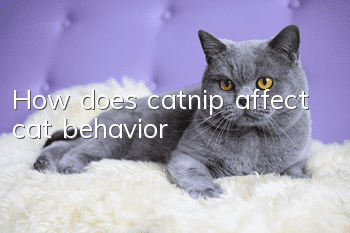How does catnip affect cat behavior?

For all our scientific knowledge, we still haven’t uncovered the secret of how catnip attracts cats. According to the dictionary definition, "Catnip is a strong-smelling mint ( Nepeta cataria ) with small, light-colored flowers that bloom in terminal spikes and contains a substance that is attractive to cats."
But, although it remains a mystery, the substance that attracts cats has been isolated. It is a volatile terpenoid with a specific chemical name: nepetalactone. Nepetalactone is not attractive to all cats; only about 30 to 70 percent of cats are actually attracted to it. But when it works, it really works and seems to drive the cat crazy with excitement.
Catnip Journey
Cats react to catnip with ecstasy and boundless happiness.
They were given:
Sniff, chew and hit around the source of catnip, drooling profusely
Shake your head
Rolling and rubbing yourself on the floor
Becoming ataxic, falling and stumbling
Kick forward with both back legs
Excitement and chasing behavior
The theory behind catnip
No one really knows why catnip is so attractive to cats. It's also unclear what feelings it triggers and what behaviors it unleashes.
The following are some possible interpretations and discussions of the points that emerged:
Some behaviors look like playing, so under the influence of catnip, cats do seem to be in a good mood and having fun.
Chewing and salivation appear to be appetitive responses related to food acquisition.
Rolling and rubbing appear to be a sexual behavior that mimics being in heat.
Tandem hind kicking behavior may indicate predatory behavior.
Chase behavior also indicates a predatory element.
So, what kind of explanation is this?
Maybe they are both right. Catnip seems to ignite everything, exhilarating cats and bringing them out of their inhibitions. This means a general stimulant effect on brain regions, particularly those centered on and surrounding the hypothalamus, which controls appetite, predatory and sexual behavior.
Recent evidence suggests that nepetalactone's molecules have an opioid (opium-like) shape and indeed have opium-like effects. It stimulates certain types of opioid receptors in the same way as morphine. You may ask why an innocent plant could contain such a powerful chemical. The answer may be to attract insects, which then assist the aliensFlowers pollinate or otherwise help plants (e.g., attracted wasps eat aphids). Plants in the Lamiaceae family may have evolved the ability to make cyclopentane, a known insect sex pheromone, to attract insects to assist in their own reproductive cycles.
A cat with a long nose comes looking for fun and discovers this interesting, possibly pheromone-attractive plant, which it begins to study and possibly chew. If he or she does absorb nepetalactone, the brain's opioid receptors, pleasure centers, and "go" systems are activated, and the cat wallows in ecstasy. Studies have shown that exposure to nepetalactone can produce amphetamine-like effects in some animals and lead to certain repetitive behaviors. This is consistent with the opioid activation theory, as opioids do stimulate "go system" neurochemicals (aka catecholamines) in some species, including cats and horses, much like amphetamines do.
Conclusion
All of this may sound far-fetched, but it does explain known, observable facts. This also explains why some cats are immune. If a cat initially attracted to catnip does not ingest the substance, it will not discover the "forbidden fruit" and remain indifferent to its hidden pleasures.
While it might seem logical to assume that the estrus-like behavior released by catnip is a unique female phenomenon, this is not the case. Males also have rolling and rubbing behaviors that are characteristic of estrus. This can be explained by the fact that no behavior is unique to either gender, not even sex.
While some may be philosophically opposed to the inebriation, appetite, and seemingly erotic state produced by catnip, it has not been shown to be harmful and may even be beneficial in some cases. Aggressive cats who are sensitive to catnip will see each other in a new light after using catnip on one or both cats. Additionally, catnip's analgesic properties may be helpful for cats in pain. It seems that catnip has similar effects on cats as marijuana does on people. Fortunately, we don't need a movement to legalize catnip for medical use on our feline friends.
- A cat will die if it urinates for a few days
- Should you deworm yourself or go to a pet store?
- Are cat teasers harmful to cats?
- What should I do if my cat suffers from chronic gingivitis?
- Cat's nails are cracked with a thin layer
- Cats go crazy after eating mutton
- What does cat moss on a cat’s chin look like?
- Can cats reproduce after abdominal transmission is cured?
- What exactly is the sterilization shot for female cats?
- Can I still eat unopened cat food if it has expired?



